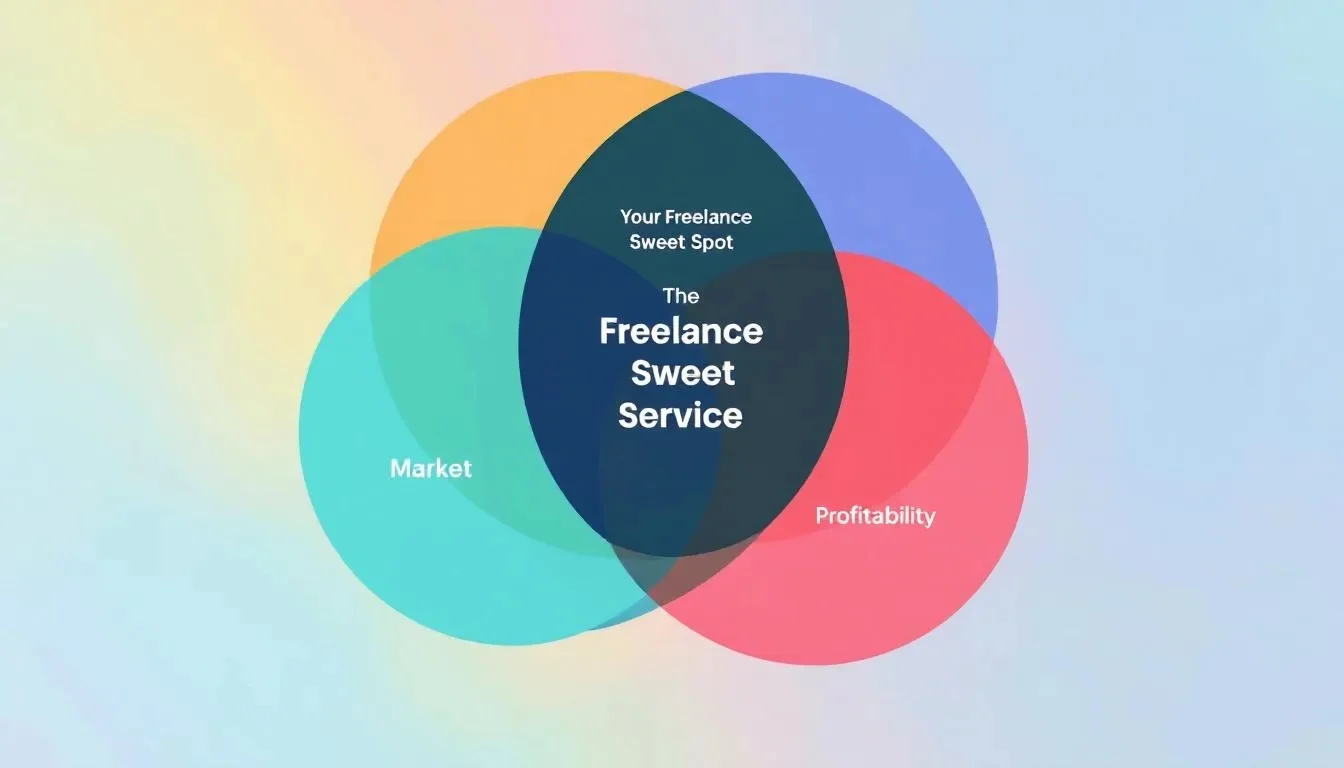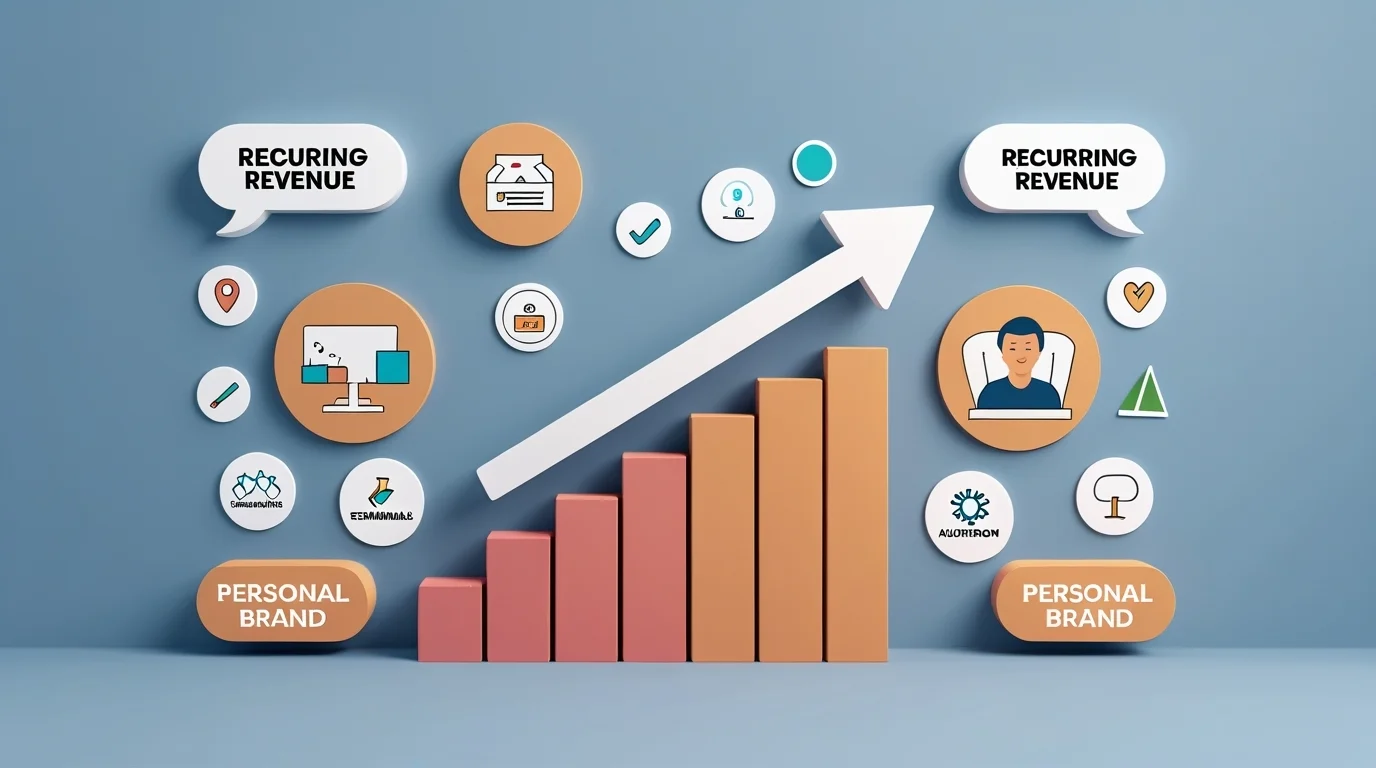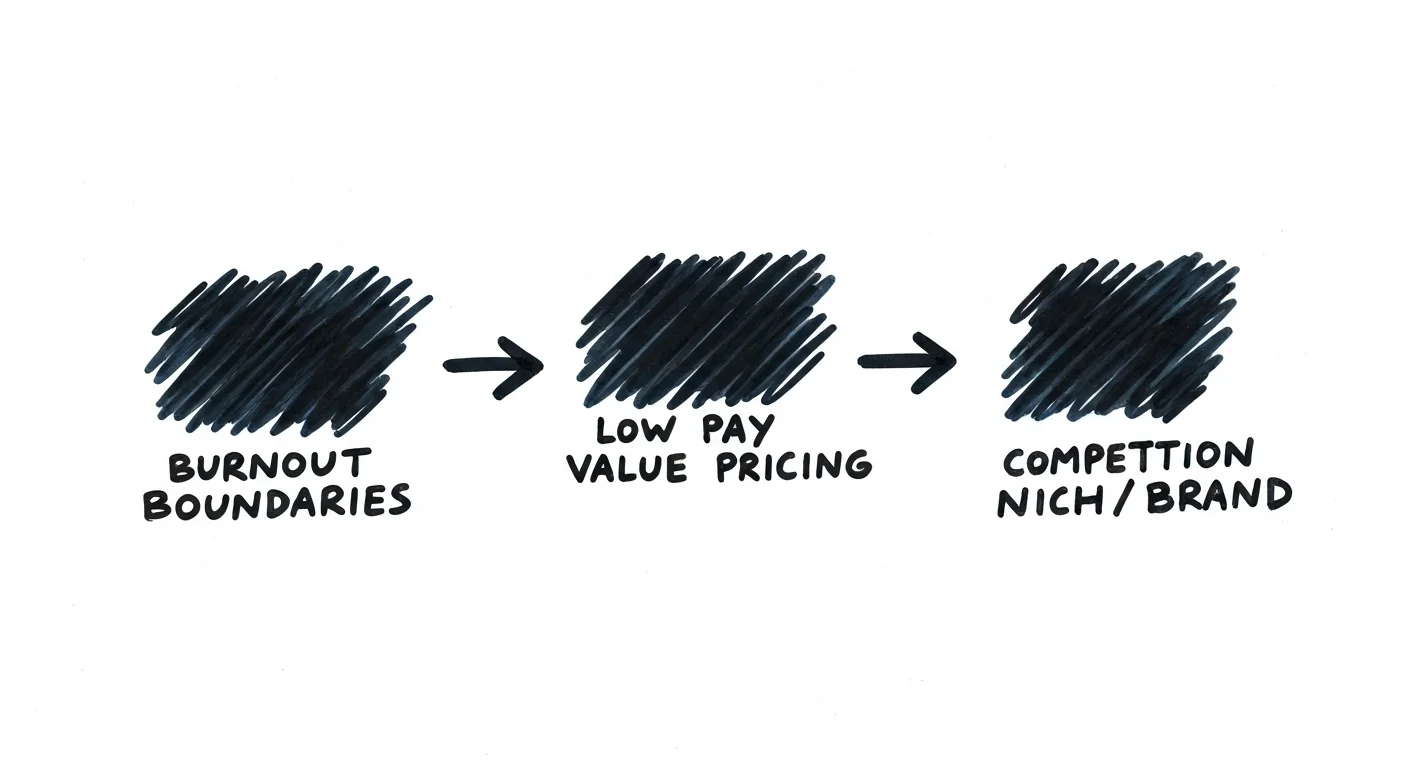It is an incredibly dynamic and opportune moment to possess valuable skills in graphic design, writing, or programming. With the accelerating shift towards freelancing, remote work, and the gig economy, creative and technical professionals now have unprecedented avenues to transform their expertise into robust, sustainable income streams. Whether you're a budding talent taking your first steps or a seasoned pro looking to scale your existing work, this definitive guide will equip you with the strategies to package your skills, attract high-quality clients, and cultivate a steady, fulfilling income doing what you love.
From crafting an irresistible portfolio to setting competitive rates, mastering client acquisition on platforms like Upwork and Fiverr, and leveraging the power of LinkedIn, here's everything you need to know to establish and grow a thriving freelance career fueled by your unique talents.
Step 1: Identify Your Strongest & Most Profitable Skills— Specialize to Stand Out

In the vast landscape of freelancing, a common mistake is trying to be a generalist. While versatility is good, specialization is key to attracting higher-paying clients and building a strong reputation. Begin by critically assessing which of your skills are not only strongest but also align with demonstrable market demand and offer significant value.
Assess Your Core Expertise & Tools:
Graphic Designers: Beyond general design, what are your deep strengths? Are you a master of branding & identity design, an expert in UX/UI design for mobile apps, a wizard with social media graphics & content, a specialist in print design (brochures, packaging), or an artist creating illustrations & digital art? List the specific software you're highly proficient in (e.g., Adobe Creative Suite, Figma, Sketch, Canva Pro).
Writers: What writing formats do you excel in? Are you a compelling content writer for SEO-friendly blogs, a persuasive copywriter for sales pages & ads, a meticulous technical documentation writer, a versatile ghostwriter, a specialist in email marketing campaigns, or a researcher crafting white papers & case studies?
Programmers: What languages, frameworks, or platforms are your superpowers? Do you specialize in web development (frontend/backend/full-stack), mobile app development (iOS/Android), software engineering, e-commerce solutions, database management, API development, or niche areas like blockchain, AI/ML model deployment, or cybersecurity?
Research Market Demand & Profitability:
Freelance Platforms: Browse popular platforms like Upwork, Fiverr, and Guru. Look at "most in-demand skills" sections, analyze job postings, and observe what successful freelancers in your field are offering.
Industry Reports: Consult reports on digital marketing trends, software development needs, or design forecasts. These can highlight emerging hot skills.
LinkedIn & Professional Networks: See what skills are frequently listed in job descriptions for your target roles and what skills are endorsed on profiles of successful professionals.
Competitor Analysis: Identify successful freelancers in your chosen niche. What specific services do they offer? How do they differentiate themselves?
Identify Pain Points: Think about what businesses are struggling with. Do they need more engaging content, a better user experience, or automated processes? Your skills should directly address these needs.
Pro Tip: Don't just pick a skill; pick a problem you can solve with that skill. For example, instead of just "website design," consider "designing high-converting Shopify stores for fashion brands." This level of specificity makes you highly marketable.
Step 2: Package Your Services for Success—Clarity & Value Drive Sales
Once you've identified your niche and core strengths, the next crucial step is to package your skills into clear, compelling service offerings. Your goal is to make it incredibly easy for potential clients to understand exactly what you offer, the value it provides, and how much it costs.
Define Clear Deliverables & Outcomes:
Break down your work into tangible results. Avoid vague descriptions.
Graphic Designers: Offer packages like "Brand Identity Starter Kit (Logo, Color Palette, Typography Guide)," "Social Media Engagement Pack (10 Custom Templates + 5 Story Designs)," and "Website UI/UX Audit & Redesign Proposal."
Writers: Structure offerings around "SEO Blog Post Series (4 x 1000-word articles + keyword research)," "5-Part Email Marketing Funnel (Welcome, Nurture, Sales)," and "Website Content Revamp (Homepage, About Us, Services pages)."
Programmers: Provide services like "Custom WordPress Plugin Development," "E-commerce Website Setup (Shopify/WooCommerce)," "Mobile App MVP (Minimum Viable Product) Development," and "API Integration & Optimization."
Consider add-ons: Offer optional enhancements like extra revisions, faster delivery, a discovery call, or ongoing support.
Develop a Strategic Pricing Model:
Research Competitors: Get a realistic idea of industry standards within your specific niche and experience level.
Value-Based Pricing: This is often superior to hourly. Instead of charging for your time, charge for the value you deliver (e.g., a logo that helps a client stand out and attract customers, a blog post that generates leads, or an app that streamlines operations).
Project-Based Pricing: Define a fixed price for a specific scope of work. Clients love predictability.
Tiered Packages: Offer "Good," "Better," and "Best" options. This allows clients to self-select based on budget and needs, often leading to higher average project values.
Example for a writer: Basic Blog Post ($X), Standard Blog Post (Basic + SEO optimization + 1 revision for $Y), Premium Blog Post (Standard + content strategy call + social media snippets for $Z).
Retainers/Subscriptions: For ongoing work, offer a monthly retainer fee. This provides you with predictable recurring income and gives clients peace of mind.
Example: Monthly social media graphic package, ongoing blog content, monthly website maintenance.
Hourly Rate (Use Cautiously): While common for troubleshooting or undefined scopes, avoid it for large projects where your efficiency might penalize you. An experienced programmer might charge $75-$150+/hour, while a writer might charge $50-$100/hour for specific tasks.
Adjust Over Time: As you gain experience, build a strong portfolio, and accumulate positive testimonials, confidently increase your rates.
Craft a Clear Proposal Process:
For custom projects, provide professional, detailed proposals that outline the scope, deliverables, timeline, pricing, and payment terms. This signals professionalism and avoids misunderstandings.
Step 3: Build a Portfolio That Stands Out & Converts—Your Silent Salesperson

A polished, diverse, and results-oriented portfolio is your single most effective tool for landing clients and distinguishing yourself in a competitive marketplace. It’s your visual resume.
Create Compelling Work Samples (Even Without Clients):
Don't wait for paying clients. Proactively create projects that showcase your ideal work.
Graphic Designer: Create mock brand identity packages for fictional companies, redesign existing popular websites/apps (spec work), or participate in design challenges.
Writer: Write sample blog posts or product descriptions for non-existent (or real, but not contacted) brands in your target niche. Create a sample white paper, a short e-book, or an email sequence.
Programmer: Develop a small, functional app or website that solves a simple problem. Contribute to open-source projects on GitHub. Create a demo of a specific algorithm or integration.
Redesign/Rewrite/Rebuild: Take an existing public design, piece of writing, or website and showcase how you would improve it, explaining your reasoning.
Leverage Professional & Niche Platforms:
You don't need a complex, expensive website initially.
For graphic designers, Behance and Dribbble are industry standards.
For writers: Medium (for blog samples), Clippings.me (online portfolio for published work), or a simple WordPress blog to host your samples.
For programmers: GitHub (essential for code projects), CodePen (for front-end examples), or live demo links to deployed applications.
Your Own Simple Website: Eventually, create a clean, professional website that acts as your central hub, linking to all your samples and providing a clear "Hire Me" call to action.
Highlight Results & Impact (Metrics Matter!) :
Wherever possible, quantify your achievements. Clients care about outcomes.
Graphic Designer: "Designed a new logo that increased brand recognition by X% (based on survey)." "UX improvements led to a Y% increase in conversion rates."
Writer: "SEO-optimized blog posts increased the client's organic site traffic by 20% in 3 months." "The email campaign generated $Z in sales."
Programmer: "Developed a custom script that reduced data processing time by 40%." "Built an e-commerce platform that handled 10,000 transactions/day with 99.9% uptime."
Even for sample projects, set hypothetical goals and explain how your solution would achieve them.
Curate & Update Regularly:
Only showcase your best work. Quality over quantity.
Continuously update your portfolio with new, relevant projects that align with the type of work you want to attract.
Step 4: Find & Attract High-Quality Clients—Your Client Acquisition Strategy
Finding your first few clients can feel daunting, but with a structured approach, it becomes manageable and, eventually, repeatable.
Leverage Freelance Platforms (Strategic Use):
For beginners, Upwork and Fiverr are excellent starting points. They connect freelancers with clients globally and offer a wide range of opportunities. Start with smaller projects to build reviews and ratings.
Tips for Success: Create a compelling profile, use strong keywords, respond quickly, over-deliver on initial projects, and actively solicit 5-star reviews.
For experienced pros, platforms like Toptal (highly vetted for the top 3% of talent in dev/design/finance) and Freelancer.com can offer higher-level, more complex projects.
Niche Platforms: Look for platforms specific to your industry (e.g., WriterAccess for content, Dribbble Jobs for design, Stack Overflow Jobs for programming).
Network Strategically on LinkedIn:
Optimize Your Profile: Treat your LinkedIn profile as an online resume and portfolio. Highlight your specializations, skills, and link to your portfolio.
Share Your Work: Regularly post relevant content, insights, and samples of your work. Use industry-specific hashtags (e.g., #webdesign, #contentmarketing, #pythondeveloper).
Engage in Groups: Join industry-specific LinkedIn groups. Participate in discussions, answer questions, and offer valuable insights.
Direct Outreach (Personalized): Identify potential client companies or individuals (e.g., marketing managers, HR directors, startup founders) in your target niche. Send personalized connection requests and a polite, brief pitch outlining how you can solve a specific problem they might have. Avoid generic copy-pasted messages.
Tap Into Your Existing Network (The Power of Referrals):
Spread the Word: Inform family, friends, former colleagues, and acquaintances about your services. Clearly define who your ideal client is and what problems you solve.
Referral Programs: Consider offering a small referral bonus to anyone who sends a successful new client your way. Many freelancers secure initial clients through personal connections, which can be faster and more trustworthy than cold outreach.
Content Marketing (Attract Clients Organically):
Blog/Video/Podcast: Create valuable content (blog posts, YouTube videos, LinkedIn articles) that addresses your target clients' pain points and showcases your expertise.
SEO: Optimize your content so potential clients find you when searching for solutions you offer.
Example: A writer might write a blog post, "How Small Businesses Can Use SEO to Double Website Traffic." A graphic designer might create a video, "5 Figma Tips for Faster UI Design." A programmer might write about "Choosing the Right Database for Your SaaS MVP."
Cold Outreach (Targeted & Professional):
Identify businesses that clearly need your service (e.g., a website with a terrible design, a company with no blog, or a manual process that could be automated).
Craft a highly personalized email or LinkedIn message. Focus on their pain point, quickly introduce how your service can solve it, and include a link to a relevant portfolio piece. Keep it concise and low-pressure.
Step 5: Scale Your Freelancing into a Thriving Business—Beyond the Hourly Grind

Once you've secured a few clients and established a rhythm, it's time to elevate your freelancing from a series of gigs to a sustainable, thriving business.
Prioritize Recurring Revenue Models:
Retainers: Offer monthly or quarterly retainer agreements for ongoing services. This provides predictable income and strengthens client relationships.
Graphic Designer: Monthly social media content package, ongoing branding support.
Writer: Ongoing blog content creation, monthly newsletter management.
Programmer: Monthly website/app maintenance, ongoing feature development, and security audits.
Subscription-Based Services: Package a specific set of services into a subscription model.
Example: "Basic WordPress Security & Update Subscription."
Master Upselling and Cross-selling:
Once you've delivered excellent work and built trust with a client, suggest additional services that genuinely benefit them.
Example: After designing a logo, offer a full brand guide. After writing blog posts, suggest an email marketing campaign to distribute them. After building a website, propose ongoing maintenance or a custom integration.
Approach: Frame it as a solution to their next problem, not just selling more.
Leverage Client Testimonials and Case Studies:
Your Best Marketing: Happy clients are your most powerful marketing tool. Actively ask for testimonials, especially after successful projects.
Detailed Case Studies: Go beyond a short quote. Create in-depth case studies that outline the client's original problem, your solution, and the measurable results achieved. Display these prominently in your portfolio, social profiles, and proposals. Positive feedback builds immense credibility and attracts new, high-quality clients.
Build Your Personal Brand & Authority:
Thought Leadership: Share your insights, opinions, and expertise through a personal blog, LinkedIn articles, or speaking engagements.
Online Presence: Maintain a consistent, professional presence across all relevant online platforms.
Niche Authority: By consistently delivering excellent work and sharing valuable insights within your niche, you become a recognized authority, attracting clients who seek out specialists.
Automate & Optimize Your Workflow:
Tools: Use project management tools (Asana, Trello), invoicing software (FreshBooks, Wave), time-tracking apps (Toggl), and communication platforms (Slack) to streamline your operations.
Templates: Create templates for proposals, contracts, invoices, and communication to save time.
Outsource (Carefully): As you scale, consider outsourcing non-core tasks (e.g., administrative work, specialized design elements if you're a writer) to free up your time for billable work.
Invest in Continuous Learning:
The digital world evolves rapidly. Stay current with new technologies, trends, and best practices in your field. This keeps your skills sharp and marketable.
Common Challenges & How to Overcome Them

Freelancing offers immense freedom, but it comes with its own set of challenges:
Finding Consistent Work:
Solution: Diversify your client acquisition strategies (platforms, networking, content), build an email list, and prioritize recurring revenue.
Pricing Your Services:
Solution: Research thoroughly, understand your value, start with project-based rates, and don't be afraid to raise prices as you gain experience and testimonials.
Managing Client Expectations:
Solution: clear contracts, detailed proposals, regular communication, and setting boundaries from the start.
Burnout & Work-Life Balance:
Solution: Set clear working hours, learn to say "no," schedule breaks, and automate repetitive tasks. Remember why you started freelancing.
Competition:
Solution: Specialize, differentiate through superior quality and client experience, build a strong personal brand, and continuously learn new skills.
Your Skills Have Incredible Potential: It’s Time to Unlock It!
Turning your abilities in graphic design, writing, or programming into a thriving income stream isn’t just about making money; it’s about claiming autonomy, igniting your creativity, and leveraging your technical prowess in ways that genuinely excite you. You gain the freedom to choose your projects, set your own schedule, and build a career aligned with your passions.
The key to success is to start small, stay consistent, and commit to continuous improvement. Gradually build your portfolio, meticulously refine your services, and genuinely invest in nurturing strong client relationships. With dedication and strategic effort, you will cultivate a robust, sustainable source of income fueled by your invaluable talents.
Are you ready to take control of your career and redefine your professional future? Your skills have incredible potential; it’s time to turn them into unparalleled opportunities.



